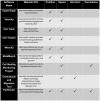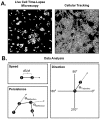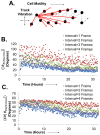The development of a novel high throughput computational tool for studying individual and collective cellular migration
- PMID: 24386097
- PMCID: PMC3873918
- DOI: 10.1371/journal.pone.0082444
The development of a novel high throughput computational tool for studying individual and collective cellular migration
Abstract
Understanding how cells migrate individually and collectively during development and cancer metastasis can be significantly aided by a computation tool to accurately measure not only cellular migration speed, but also migration direction and changes in migration direction in a temporal and spatial manner. We have developed such a tool for cell migration researchers, named Pathfinder, which is capable of simultaneously measuring the migration speed, migration direction, and changes in migration directions of thousands of cells both instantaneously and over long periods of time from fluorescence microscopy data. Additionally, we demonstrate how the Pathfinder software can be used to quantify collective cell migration. The novel capability of the Pathfinder software to measure the changes in migration direction of large populations of cells in a spatiotemporal manner will aid cellular migration research by providing a robust method for determining the mechanisms of cellular guidance during individual and collective cell migration.
Conflict of interest statement
Figures



 ) methods for measuring migration persistence yields identical trends in both the presence and absence of either TGFβ or EGF for MDA-MB-231 cells and HaCaT cells. Double asterisks indicate a p value<0.01. Each condition represents greater than 200 cells for persistence time measurements, and greater than 1000 cells for average absolute angle of deflection measurements.
) methods for measuring migration persistence yields identical trends in both the presence and absence of either TGFβ or EGF for MDA-MB-231 cells and HaCaT cells. Double asterisks indicate a p value<0.01. Each condition represents greater than 200 cells for persistence time measurements, and greater than 1000 cells for average absolute angle of deflection measurements.


References
-
- Chambers AF, Groom AC, MacDonald IC (2002) Dissemination and growth of cancer cells in metastatic sites. Nat Rev Cancer 2: 563–572. - PubMed
-
- Friedl P, Wolf K (2003) Tumour-cell invasion and migration: diversity and escape mechanisms. Nat Rev Cancer 3: 362–374. - PubMed
-
- Keller R (2005) Cell migration during gastrulation. Curr Opin Cell Biol 17: 533–541. - PubMed
-
- Locascio A, Nieto MA (2001) Cell movements during vertebrate development: integrated tissue behaviour versus individual cell migration. Curr Opin Genet Dev 11: 464–469. - PubMed
-
- Montell DJ (2003) Border-cell migration: the race is on. Nat Rev Mol Cell Biol 4: 13–24. - PubMed
Publication types
MeSH terms
Grants and funding
LinkOut - more resources
Full Text Sources
Other Literature Sources

